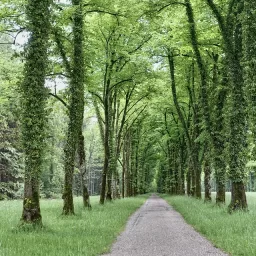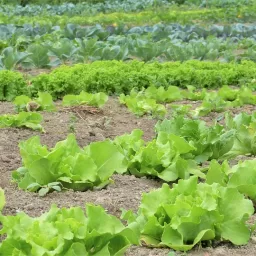Beauty and the Beast – Trumpet Vine, Rose of Sharon, Sumac – Why Grow These Shrubs? It’s a Paradox
Trumpet Vine, Rose of Sharon, Sumac. Why would anyone want to plant these shrubs in the landscaping of a pool, patio or outdoor living area? Each of them is a beast that can never be totally tamed, a beast that will require diligence and persistence to control and keep at bay.
The answer to this question lies not in their beastly qualities but in their beauty. It is a paradox worth examining.
Beauty and the Beast is a classic fairy tale based on a paradox. A paradox is a literary term defined briefly as the juxtaposition of two seemingly contradictory or conflicting images or ideas that ironically do not contradict or conflict; rather, when taken together the paradoxical terms actually form a striking new perspective on, or truth about their topic. The beauty Belle and the Beast should not fall in love but they do and their love sheds new light on the nature of relationships and love itself. Paradox, though, is not just a literary term; it is a reality of life, a complexity that adds interest and beauty to whatever aspect of life it manifests. That reality includes the landscaping of an outdoor living area.
Yes, trumpet vine, rose of sharon and sumac are all beasts, but they are also beauties that can be worth the struggle. It is, however, important to understand the dark side of their nature before committing them to any landscape project..
All three of these shrubs share the same beast-like tendencies. They are predators with a pack mentality that wants to ever expand, conquer and dominate new hunting grounds. In plain terms, they will spread everywhere if allowed to. They will grow outward from the spot of original planting; they will also spring up all over the yard at considerable distances where least expected or even wanted. If allowed to establish at any new location they will be that much harder to control. Constant vigilance will be required. This is not a war that can be ultimately won but a battle that will be fought over and again forever. Remember, though, that gardening, like life, is a journey and most of its greatest rewards come from surmounting the obstacles of the journey, not in reaching the end destination.
So, why grow trumpet vine, rose of sharon and sumac? Very simply, because each is a beauty and each is worth the effort.
Trumpet vine is a climber, like ivy, that can be grown up and over any structure. The bright orange, cone or trumpet-shaped flowers will attract humming birds to provIde breath-catching entertainment. This vine can transform a plain chain link fence into a living privacy wall as attractive as any hedge but less demanding of space. Grown on a trellis, it can be used as a room divider on a patio or deck. An inviting entrance way to an outdoor living area can be created by growing trumpet vine over a cedar arbor or a series of these covered arbors can be arranged along a pathway to form a shady walk from one outdoor room to another. Place a garden bench, porch swing or glider partway along this walk for a romantic retreat. One segment of a poolside patio can be cover with a simple pagoda overgrown with trumpet vine to provide a shaded escape from the sunning deck when desired. This covered pagoda could house a few comfy adirondack chairs, another swing or a dining table for poolside meals. This vine can also twist around and up a single stake to form a small, umbrella-shaped flowering specimen tree for a yard or garden.Any of these options makes trumpet vine worth the struggle to control it.
Next, rose of sharon is a small tree and a member of the hibiscus family, a poor cousin perhaps but a hardy one. It will survive and flourish in cooler climate zones in the northern states and Canada where hibiscus will not. Its flower is somewhat smaller and less luxuriant than hibiscus but still beautiful and very plentiful exploding from the ends of its branches from mid-summer through autumn when many other garden flowers are starting to fade out. Shades of purple are dominant, ranging from pinkish tones to lighter mauves and deeper lilacs; some beauties however are bright white with a deep red heart. The trees can be allowed to grow larger to center a yard or garden; they can also be kept smaller and trimmed into an inverted cone shape that gives them the appearance of a giant vase of flowers when in full bloom; finally, they can even be grown close together in a row to create an eye-catching hedge. Rose of sharon, then, is also worth the effort of containing it.
Finally, hail the lowly sumac. These fast growing trees are often seen growing in ditches and marshy areas and along the sides and medians of major highways. Many consider them to be no more than weeds or scrub growth, unworthy of any serious garden,or the landscaping of a well designed outdoor living area. Some of us, however, exclaim: NOT SO! Upon closer examination certain unique and appealing features present themselves. In the spring, the new growth branches have a soft, furry or downy texture much like cottontails or the antlers of young bucks. The flowers are large corncob shaped clusters in a deep auburn or rust colour that resemble tropical fruit appearing in late summer and lasting often until the snow flies. The leaves are long, pointed, green ovals that grow along either side of young branches, often weighing them down somewhat to give a drooping appearance; in the autumn when the colours change, they range from banana, through orange to bright pomegranate. In summer, when these leaves are dark green and drooping, the branches take on the look of palm trees, or at least the closest thing to it that can be found in climates where palms won’t grow. The fact that they grow so fast and often strangely allows them to be trimmed and shaped however the owner desires, much like a bonzai tree; they can be grown to resemble tall or short palms, or even be made to take on a windblown ragged look borrowed from a northern lake or cliff. There are also more sophisticated varieties that have been cultured to have even furrier branches, split leaves like japanese maples and bright yellow leaves. Thus, no gardener, landscaper or homeowner should be afraid to give the lowly sumac fair consideration before dismissing them as no more than a weed and nuisance.
To conclude, in his classic novel, A Tale of two Cities, Charles Dickens said of life in France before the revolution: “It was the best of times; it was the worst of times” – another famous paradox. Well, having any one or all of these three shrubs – trumpet vine, rose of sharon and sumac – in a garden or the landscaping of an outdoor living area, can be just that: at once the best and worst of times. They are all beauties and they are all beasts. That duality should be embraced; the ensuing journey will be its own reward.
grow weed
#Beauty #Beast #Trumpet #Vine #Rose #Sharon #Sumac #Grow #Shrubs #Paradox
Will be pleased to have you visit my pages on social networking .
Facebook page here.
Twitter account is here.
Linkedin account here
Post byBedewy for info askme VISIT GAHZLY



